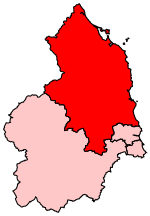Chillingham, Northumberland

Chillingham is a village in Northumberland, England. It is situated approximately 6 km (3.7 mi) to the east of Wooler, south of Chatton. At the 2011 Census the population remained less than 100. Detailed information is included in the parish of Bewick. Chillingham is famous for its castle, which is said to be haunted, and the Chillingham Cattle, a wild herd of roughly 90 individuals which has been kept in an enclosure since the Middle Ages and strictly inbreeding for at least 300 years. The village contains Hebborn bastle house, a fortified house near Hepburn Wood.HMS Chillingham, a Ham class minesweeper, was named after the village. The civil parish, along with those for Chatton and Lilburn, has been served by Tillside Parish Council since 2003, under a grouping order by the former Borough of Berwick-upon-Tweed. According to Tillside Parish Council, two councillors represent Chillingham on the council.
Excerpt from the Wikipedia article Chillingham, Northumberland (License: CC BY-SA 3.0, Authors, Images).Chillingham, Northumberland
Geographical coordinates (GPS) Address Nearby Places Show on map
Geographical coordinates (GPS)
| Latitude | Longitude |
|---|---|
| N 55.527 ° | E -1.904 ° |
Address
NE66 5NH
England, United Kingdom
Open on Google Maps








